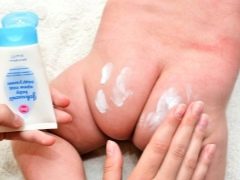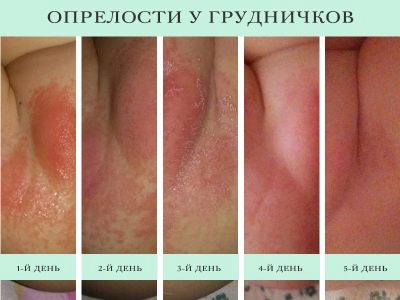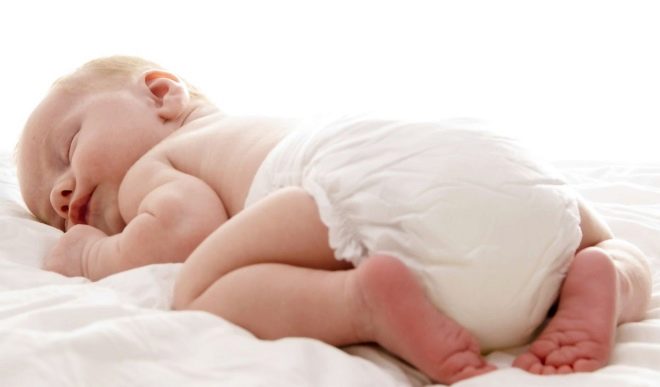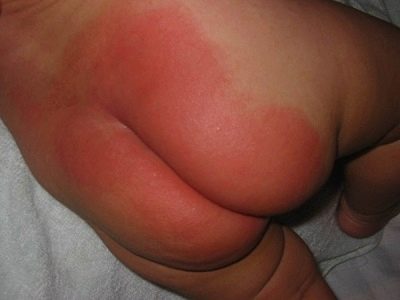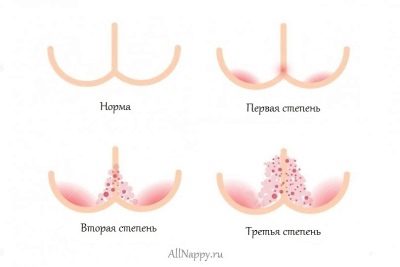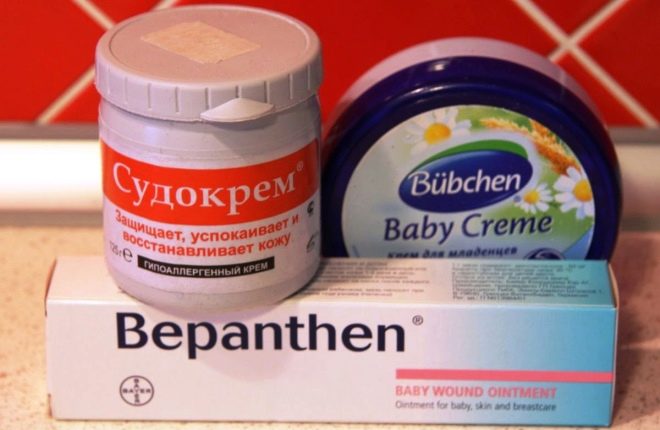Diaper rash in newborns on and between buttocks
Diaper rash on the pope in newborns and infants is a very common phenomenon that even parents who are struggling to keep up with the baby’s hygiene face. The more diligently the mother maintains the purity of the buttocks and gluteal fold, the more questions arise when redness, rashes and other unpleasant manifestations of classic diaper rash appear.
What is it?
Unsightly redness on the priest and between the buttocks of the baby, which called diaper rash, is a local inflammation. It is usually caused by the contact of delicate baby skin with urea, ammonia and feces, as well as mechanical friction, if the diaper or diaper is chosen unsuccessfully.
The skin of the kids to the age is much thinner and softer than the rest of the kids and adults. It is faster saturated with moisture, it is more vulnerable to any pathogenic bacteria, viruses and fungi. The condition of the epidermis of the baby is easy to break, because it is quickly injured, even during normal daily procedures such as massage.
The location of diaper rash on the pope is one of the most common.
When the form of the inflammatory process is neglected, pyoderma develops. If a bacterial infection spreads, sepsis can develop.
Causes of
In the inflammatory process on the buttocks and in the natural crease between them, a key role is played by impaired water and lipid balance of the skin. Excess moisture and starts the process of inflammation in the epidermis, and sometimes in the deeper layers of the skin. Any moisture is dangerous, but urine should be noted separately, especially if it is combined with feces. Gentle skin of children suffers even with a brief exposure to urea, ammonia, as well as enzymes kala - lipase and protease. If the child has loose stools, the inflammation develops even faster and stronger., because acidic medium is contained in liquid feces.
Thus, strong diaper rash on the pope is almost always the result of a violation of the hygienic requirements for the care of a newborn. Long-term stay in a disposable diaper, even after a bowel movement, is the most common cause of unpleasant symptoms.
It is noteworthy that develop diaper rash on the buttocks can and sweat. If the child is dressed too warmly, he sweats, and the thermoregulation of the children is different, special. Sweat is a salty environment that also irritates the skin, especially in the gluteal fold.
The cause of unpleasant rash on the pope can be an uncomfortable diaper, not the right size, rubbing the skin. Such a diaper rash can cause a too stiff diaper if the baby is swaddled.
The gluteal fold is deep, and therefore rubbing inside it is possible by itself, but if there are factors predisposing to inflammation, then diaper rash is very likely. These factors, in addition to violations of hygienic requirements, include an increased propensity for allergies. If a child has an allergic reaction to a new product on the menu, then it often begins with priests.. If the child is sick, and he has a high temperature, then he sweats more abundantly, and therefore diaper rash may well appear in the natural folds of the skin.
Risk group
Any mother can encounter diaper rash on the buttocks of a baby, but doctors have long noticed that There is a risk group, which includes children with similar symptoms, and they suffer from diaper rash more often than others:
- blond with fair skin;
- overweight children;
- allergy sufferers;
- suffering from intestinal dysbiosis;
- intestinal infections;
- tots with kidney or bladder diseases;
- premature babies;
- babies who do not receive breast milk, but dairy adapted formula.
How to distinguish from other problems?
For parents, it is important to learn to distinguish diaper rash in a child from other possible problems. In addition, the diaper rash themselves can be different. Therefore, it is important to learn how to understand what a mother is dealing with in order to know how to act in a given situation.
In the vast majority of cases with rashes on the pope, parents deal with diaper dermatitis.. It is in the area where the skin is in contact with urine, feces, and the inflammatory process occurs. Redness can be extended to the genitals of the baby. Neither on hands, nor on legs diaper diaper rash do not meet.
If diaper rash in an infant is concentrated mainly around the anus, between the buttocks and on the buttocks redness is insignificant, then allergies can be assumed. For its characteristic appearance, such a diaper rash is often called an “allergic ring”.
The localized inflammation of the deep gluteal fold alone is called intertrigo.. The reason for its most often lies in the sweating, excess moisture and mechanical friction.
More rarely, red spots on the pope look as distinct round, with roughness and high fat content and edema. This suggests seborrheic eczema. When a fungal infection joins, the spots have a whitish plaque, and with a bacterial complication, ulcers are almost always observed. Pustules that quickly burst and leave ugly crusts on the pope - a classic impetigo.
To distinguish diaper rash on the pope from other types of rash is quite simple. Leave the baby without a diaper for a couple of hours. If the rash begins to brighten and disappear - this is a typical diaper rash. If the spots are spread to other parts of the body, then infection should be assumed.
It is important to be able to distinguish the degree of diaper rash on the pope.
- At the first - the skin is slightly inflamed, there are no moist areas, the skin is holistic, there are no wounds or cracks. The general condition of the baby does not suffer.
- At the second degree buttocks and gluteal fold bright red with elements of erosion, there are cracks, wounds, pustules may be noticeable. The child is naughty, worried.
- Heavy, heavy, third stage diaper rash - edematous, pronounced areas of red, with cracks, eczema, ulcers. They are painful, the child’s condition is disturbed, he cries, eats badly, sleeps badly. The temperature may rise, and this is a very alarming sign, which indicates a high probability of infection.
If the child has the first degree, the mother can treat it herself, without the help of a doctor.
With the second and third degrees, you should definitely call a doctor and get a therapeutic appointment.
How to treat?
Small diaper rash on the first-degree priest can be treated at home on its own, and even without any special treatment, they pass fairly quickly and easily. In most cases, it is enough to carefully assess the living conditions of the baby - is it hot in his room, are you wrapping the child too much, is he sweating, are you always changing the diaper in time (every 3–4 hours, and when you have a bowel movement? graphics).
Arrange baby air baths - the skin must breathe. Children's cream is permissible to use only to create a protective film on healthy skin. If diaper rash has already appeared, it is prohibited to lubricate them with a fat baby cream.
Crush the baby more often. Redness on the skin will help remove Dexpanthenol or Bepanten. You can use folk remedies.
In the second degree of diaper rash, after consultation with the doctor, the mother should create the favorable conditions described above.Treatment of inflamed areas of the skin involves the treatment of drugs with a drying effect - for example, using zinc oxide-based products (“talkin”, “Desitin”, “Tsindol”). Pustules treated with antibiotic ointments (for example, "Baneocin"). Food allergy to the pope needs treatment with antihistamines.
In case of severe third-degree diaper rash, the doctor recommends therapeutic lotions with silver nitrate, tannin solution, zinc paste, as well as aniline dyes - Zelenka, Fukortsin to prevent bacterial contamination. If there are wounds or eczema on the pope, it is forbidden to sprinkle them with powder or smear them with fatty creams.
Of folk remedies, which, by the way, are allowed only with the first degree of diaper rash, baths with a decoction of oak bark, a string, and chamomile are permissible. It is forbidden to use iodine, even in diluted form, it is impossible to smear diaper rash with honey, alcohol, sprinkle with tooth powder, process with vegetable oils (The only exception is sea buckthorn oil). These measures will help to quickly get rid of mild diaper rash, while removing strong damp diaper rash is much more difficult and longer. To cure them, you need time and patience. To prevent re-occurrence - common sense is needed.
Famous pediatrician, doctor and TV presenter Yevgeny Komarovsky advises to be more attentive to the choice of disposable diapers, to maintain optimal humidity in the apartment where the baby grows (50-70%) at a temperature of maximum 21 degrees of heat. If the child is still sweating, Komarovsky advises to necessarily bathe him and change into dry clothes.
The doctor does not advise abusing children’s skin care products - they don’t need healthy skin.
